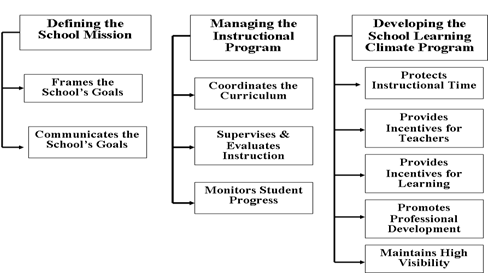Reliability and Validity
The PIMRS instrument has been validated as an instrument providing reliable results in studies of school leadership. The PIMRS assesses three dimensions of the instructional leadership construct: Defining the School’s Mission, Managing the Instructional Program, and Promoting a Positive School Learning Climate (Hallinger & Murphy, 1985).
Download access for registered PIMRS users.
These dimensions are further delineated into 10 specific instructional leadership functions. Two functions, Framing the School’s Goals and Communicating the School’s Goals, comprise the dimension, Defining the School’s Mission. Managing the Instructional Program incorporates three leadership functions: Supervising and Evaluating Instruction, Coordinating the Curriculum, Monitoring Student Progress. The third dimension, Promoting a Positive School Learning Climate includes several functions: Protecting Instructional Time, Promoting Professional Development, Maintaining High Visibility, Providing Incentives for Teachers, Providing Incentives for Learning.
 From: Hallinger, P., & Murphy, J. (1985). Assessing the instructional leadership behavior of principals. Elementary School Journal, 86(2), 217-248.
From: Hallinger, P., & Murphy, J. (1985). Assessing the instructional leadership behavior of principals. Elementary School Journal, 86(2), 217-248.
Download access for registered PIMRS users.
The original form of the PIMRS (Hallinger, 1982) contained 11 subscales and 72 behaviorally anchored items.[ Subsequent revision of the instrument reduced the instrument to 10 subscales and 50 items (Hallinger, 1984a, 1984b). For each item, the rater assesses the frequency with which the principal enacts a behavior or practice associated with that particular instructional leadership function. The item is rated on a Likert-type scale ranging from (1) almost never to (5) almost always. The instrument is scored by calculating the mean for the items that comprise each subscale/job function. This results in a profile that yields data on perceptions of principal performance on each of the 10 instructional leadership functions.
Three parallel forms of the instrument have been developed and tested: a self-assessment form to be completed by the principal, a teacher form and a supervisor form. The items which comprise each form are identical; only the stems change to reflect the differing perspectives of the role groups. Numerous studies have found significant differences in perceptions across role groups. Validation studies in the United States indicate that the PIMRS form that solicits teachers’ perceptions provides the most valid data of the three forms.
Sample Scale Items: Framing the School’s Goals
To what extent does your principal . . . ?
1. Develop a focused set of annual school-wide goals
2. Frame the school’s goals in terms of staff responsibilities for meeting
3. Use needs assessment or other formal and informal methods to secure staff input on goal development
4. Use data on student performance when developing the school’s academic goals
5. Develop goals that are easily understood and used by teachers in the school
